Influence of the Aspect Ratio of Sodium Iron Titanate Whiskers on the Mechanical and Tribological Performances of Fluorocarbon Composite Coatings
Abstract
:1. Introduction
2. Materials and Methods
2.1. Reagents and Materials
2.2. Surface Modification of Three Types of NFTO Whiskers
2.3. Preparation of NFTO/FEVE Composite Coatings via the Liquid-Phase Blending Method
2.4. Mechanical Performance Tests
2.5. Tribological Property Tests
2.6. Other Characterizations
3. Results and Discussion
3.1. Morphology and Aspect Ratio Distribution of NFTO Whiskers
3.2. Chemical Modification of NFTO Whiskers
3.3. The Cross-Sectional Morphology of NFTO/FEVE Composite Coatings
3.4. Mechanical Performances of the NFTO/FEVE Composite Coatings
3.5. Tribological Behaviors of NFTO/FEVE Composite Coatings
4. Conclusions
Supplementary Materials
Author Contributions
Funding
Conflicts of Interest
References
- Klaas, N.V.; Marcus, K.; Kellock, C. The tribological behavior of glass filled polytetrafluoroethylene. Tribol. Int. 2005, 38, 824–833. [Google Scholar] [CrossRef]
- Lin, L.Y.; Kim, D.E. Tribological properties of polymer/silica composite coatings for microsystems applications. Tribol. Int. 2011, 44, 1926–1931. [Google Scholar] [CrossRef]
- Takayanagi, T.; Yamabe, M. Progress of fluoropolymers on coating applications: Development of mineral spirit soluble polymer and aqueous dispersion. Prog. Org. Coat. 2000, 40, 185–190. [Google Scholar] [CrossRef]
- Zhou, J.; Tan, Z.; Liu, Z.; Jing, M.; Liu, W.; Fu, W. Preparation of transparent fluorocarbon/TiO2-SiO2 composite coating with improved self-cleaning performance and anti-aging property. Appl. Surf. Sci. 2017, 396, 161–168. [Google Scholar] [CrossRef]
- Li, Y.; Liu, Y.; Zuo, Y.; Chi, W.; Liu, B.; Shen, Z. Effects of dispersants on dispersion of carbon nanotubes and properties of fluorocarbon resin nanocomposites. J. Mater. Sci. 2008, 43, 3738–3741. [Google Scholar] [CrossRef]
- Jiang, X.; Wang, J.; Shen, J.; Li, R.; Yang, G.; Huang, H. Improvement of adhesion strength and scratch resistance of fluorocarbon thin films by cryogenic treatment. Appl. Surf. Sci. 2014, 288, 44–50. [Google Scholar] [CrossRef]
- Wang, Y.; Lim, S. Tribological behavior of nanostructured WC particles/polymer coatings. Wear 2007, 262, 1097–1101. [Google Scholar] [CrossRef]
- Xie, G.Y.; Zhuang, G.S.; Sui, G.X.; Yang, R. Tribological behavior of PEEK/PTFE composites reinforced with potassium titanate whiskers. Wear 2010, 268, 424–430. [Google Scholar] [CrossRef]
- Gao, Y.; Picot, O.T.; Bilotti, E.; Peijs, T. Influence of filler size on the properties of poly (lactic acid) (PLA)/graphene nanoplatelet (GNP) nanocomposites. Eur. Polym. J. 2017, 86, 117–131. [Google Scholar] [CrossRef]
- Yeo, S.M.; Polycarpou, A.A. Tribological performance of PTFE-and PEEK-based coatings under oil-less compressor conditions. Wear 2012, 296, 638–647. [Google Scholar] [CrossRef]
- Shi, Y.; Feng, X.; Wang, H.; Lu, X. The effect of surface modification on the friction and wear behavior of carbon nanofiber-filled PTFE composites. Wear 2008, 264, 934–939. [Google Scholar] [CrossRef]
- Kumar, M.; Satapathy, B.K.; Patnaik, A.; Kolluri, D.K.; Tomar, B.S. Hybrid composite friction materials reinforced with combination of potassium titanate whiskers and aramid fibre: Assessment of fade and recovery performance. Tribol. Int. 2011, 44, 359–367. [Google Scholar] [CrossRef]
- Wang, J.; Shen, L.; Bao, N. Morphology control and characteristic parameter R of molten-salt-synthesized K2Ti6O13 whiskers. J. Mater. Sci. 2019, 54, 10620. [Google Scholar] [CrossRef]
- Zhuang, G.S.; Sui, G.X.; Meng, H.; Sun, Z.S.; Yang, R. Mechanical properties of potassium titanate whiskers reinforced poly (ether ether ketone) composites using different compounding processes. Compos. Sci. Technol. 2007, 67, 1172–1181. [Google Scholar] [CrossRef]
- Liu, G.; Liu, Y.; Zhao, X. Effects of the potassium titanate functional filler types on the thermal protection performance of heat resistant ablative coated fabrics. Nano 2018, 13, 1850014. [Google Scholar] [CrossRef]
- Feng, X.; Diao, X.; Shi, Y.; Wang, H.; Sun, S.; Lu, X. A study on the friction and wear behavior of polytetrafluoroethylene filled with potassium titanate whiskers. Wear 2006, 261, 1208–1212. [Google Scholar] [CrossRef]
- Cho, K.H.; Cho, M.Y.; Kim, S.J.; Jang, H. Tribological properties of potassium titanate in the brake friction material; morphological effects. Tribol. Lett. 2008, 32, 59–66. [Google Scholar] [CrossRef]
- Shi, Y.J.; Feng, X.; Wang, H.Y.; Liu, C.; Lu, X.H. Effects of filler crystal structure and shape on the tribological properties of PTFE composites. Wear 2007, 40, 1195–1203. [Google Scholar] [CrossRef]
- Huang, T.; Li, T.; Xin, Y.; Liu, P.; Su, C. Mechanical and tribological properties of hybrid fabric-modified polyetherimide composites. Wear 2013, 306, 64–72. [Google Scholar] [CrossRef]
- Zhang, H.; Li, M.; Zhou, Z.; Shen, L.; Bao, N. Microstructure and morphology control of potassium magnesium titanates and sodium iron titanates by molten salt synthesis. Materials 2019, 12, 1577. [Google Scholar] [CrossRef]
- Zheng, H.; Shao, Y.; Wang, Y.; Meng, G.; Liu, B. Reinforcing the corrosion protection property of epoxy coating by using graphene oxide–poly(urea-formaldehyde) composites. Corros. Sci. 2017, 123, 267–277. [Google Scholar] [CrossRef]
- Qiu, S.; Chen, C.; Cui, M.; Li, W.; Zhao, H.; Wang, L. Corrosion protection performance of waterborne epoxy coatings containing self-doped polyaniline nanofiber. Appl. Surf. Sci. 2017, 407, 213–222. [Google Scholar] [CrossRef]
- GB/T 9286-1998. Paints and Varnishes – Cross Cut Test for Films; CHINESE GB Standards: Beijing, China, 1998. [Google Scholar]
- GB/T 6739-2006. Paints and Varnishes - Determination of Film Hardness by Pencil Test; CHINESE GB Standards: Beijing, China, 2006. [Google Scholar]
- GB/T 1732-1993. Determination of Impact Resistance of Films; CHINESE GB Standards: Beijing, China, 1993. [Google Scholar]
- Hu, Y.; Li, C.; Shen, L.; Bao, N. Preparation of ferric sodium titanate whisker /FEVE composite coating and its wear and corrosion resistance. Surf. Technol. 2017, 12, 71–77. [Google Scholar]
- Chang, L.; Zhang, Z.; Ye, L.; Friedrich, K. Tribological properties of high temperature resistance polymer composites with fine particles. Tribol. Int. 2007, 40, 1170–1178. [Google Scholar] [CrossRef]
- Wang, Y.; Yan, F. Tribological properties of transfer film of PTFE-based composites. Wear 2006, 261, 1359–1366. [Google Scholar] [CrossRef]
- Song, H.J.; Zhang, Z.Z.; Men, X.H.; Luo, Z.Z. A study of the tribological behavior of nano-ZnO2-filled polyurethane composite coatings. Wear 2010, 269, 79–85. [Google Scholar] [CrossRef]
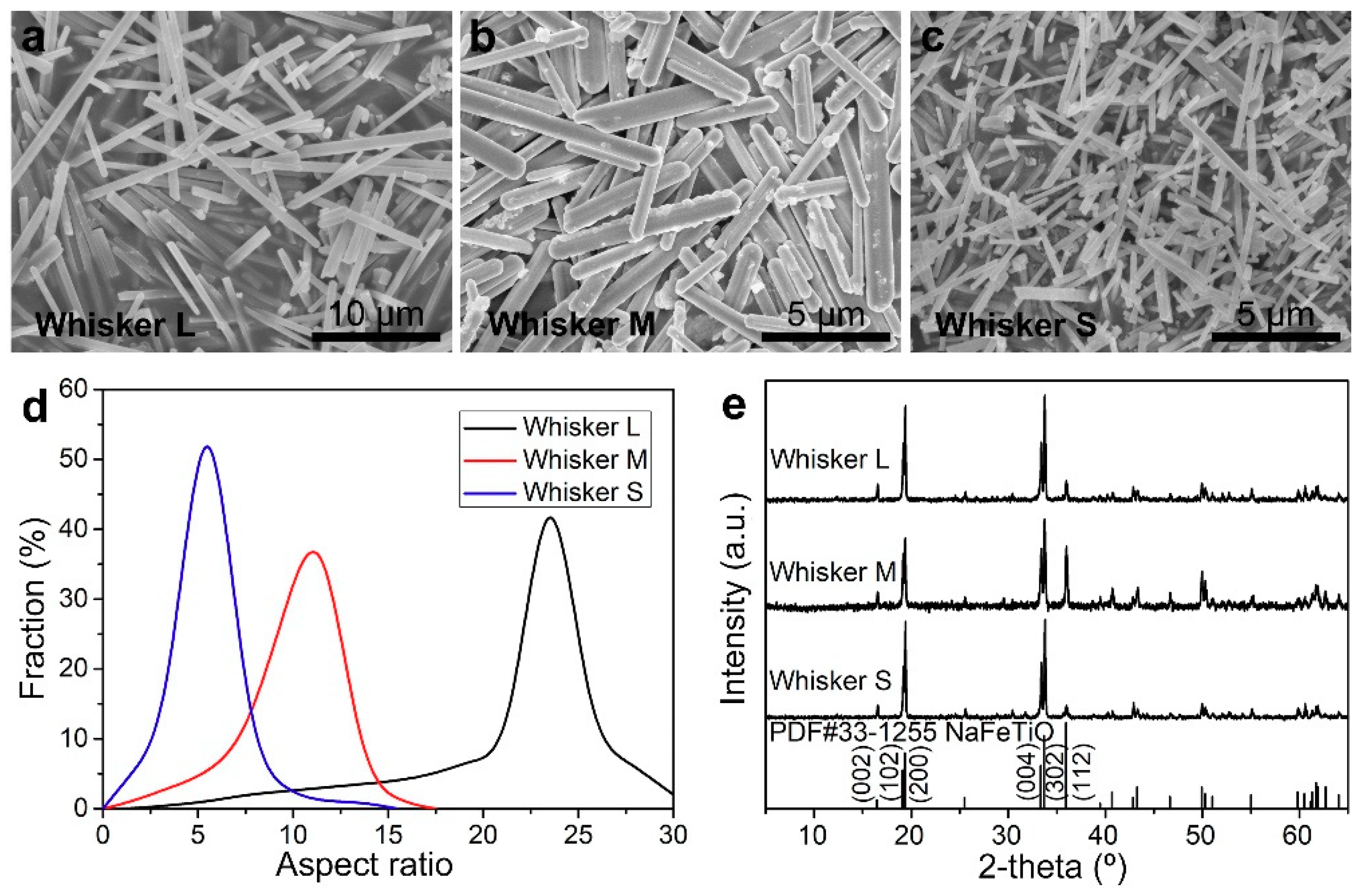
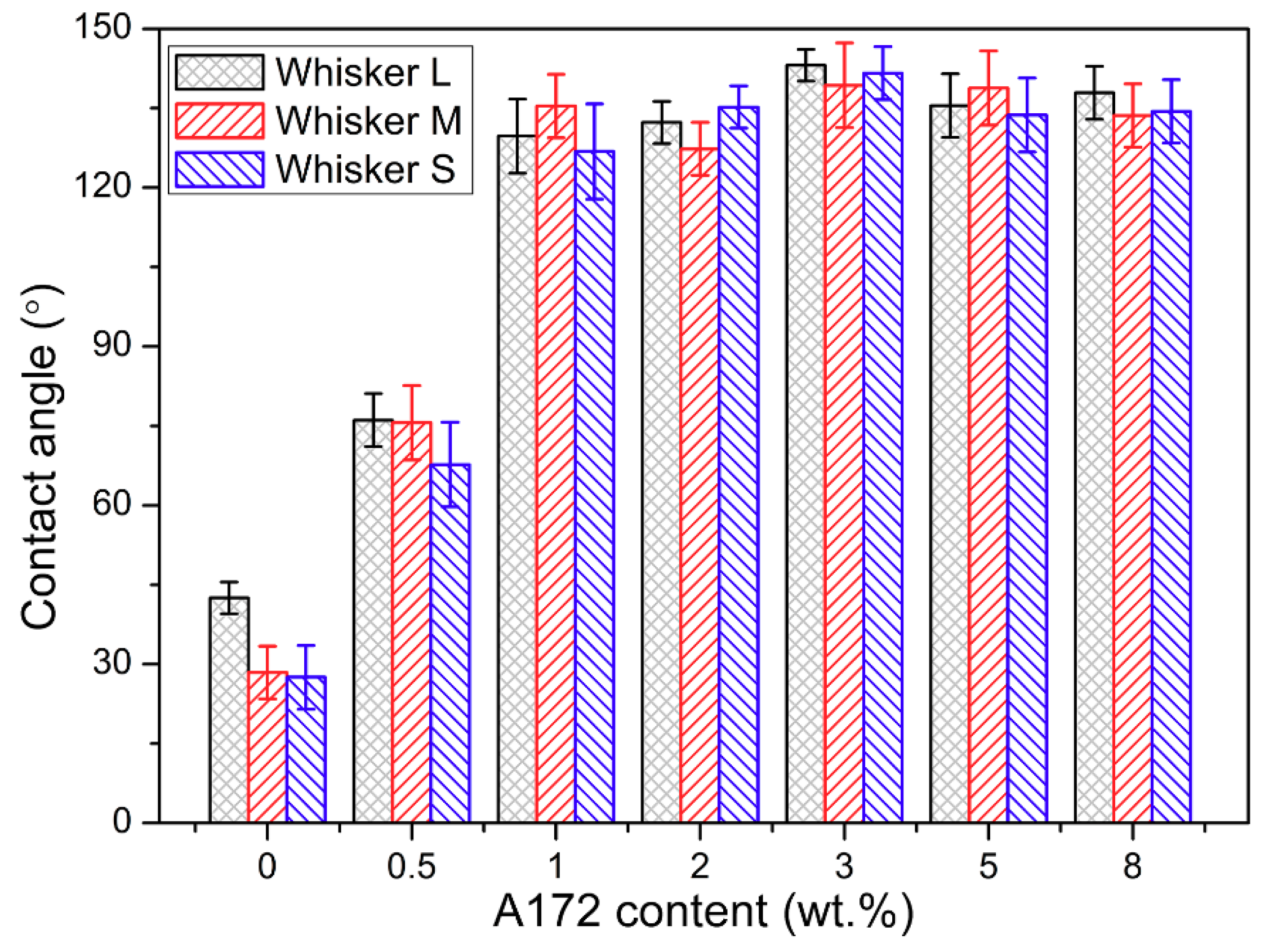
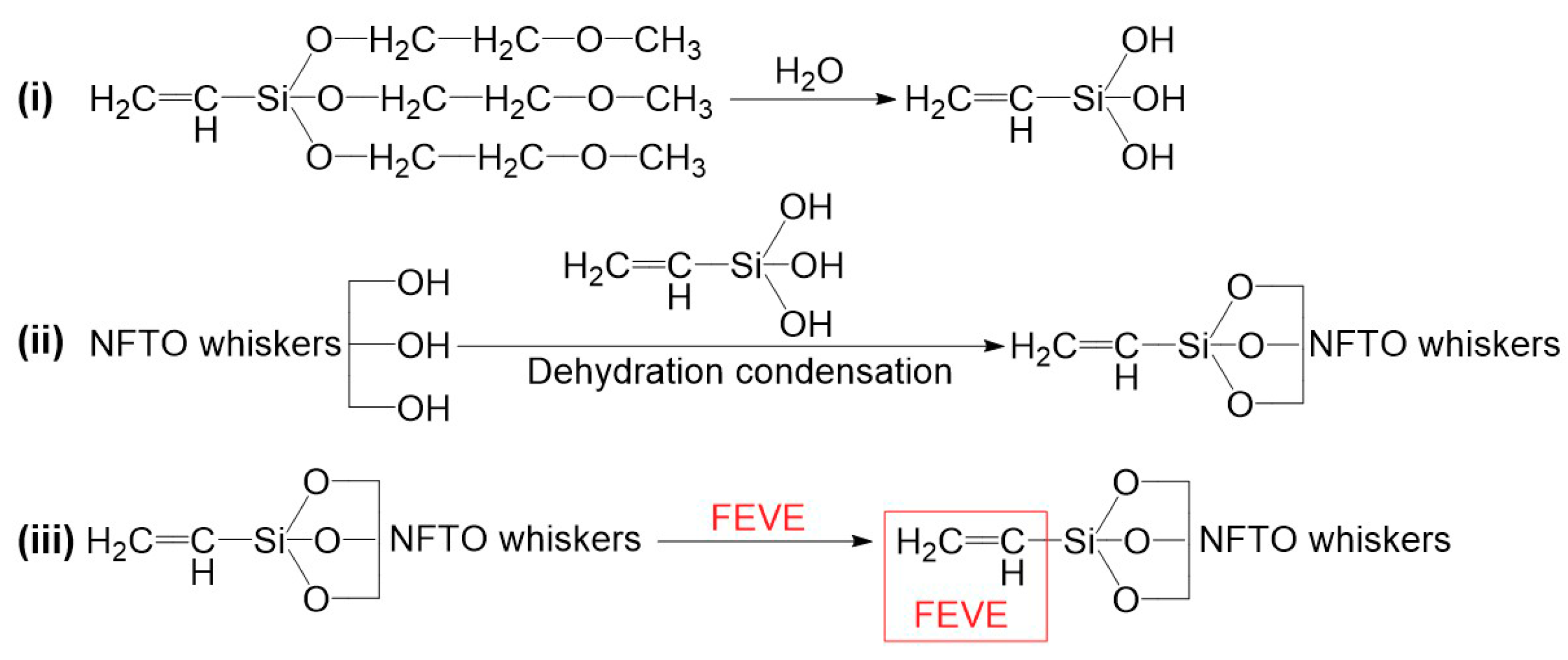

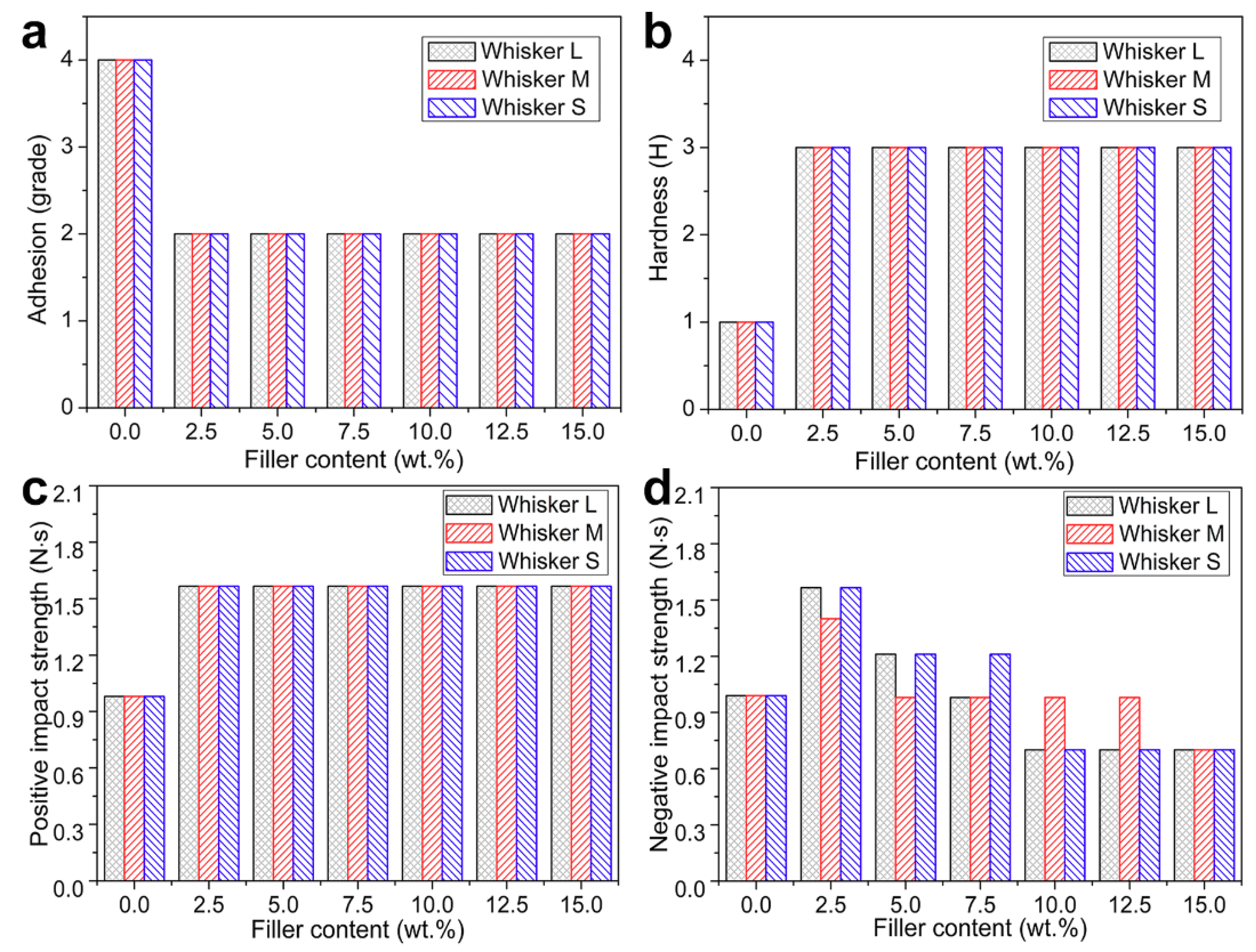

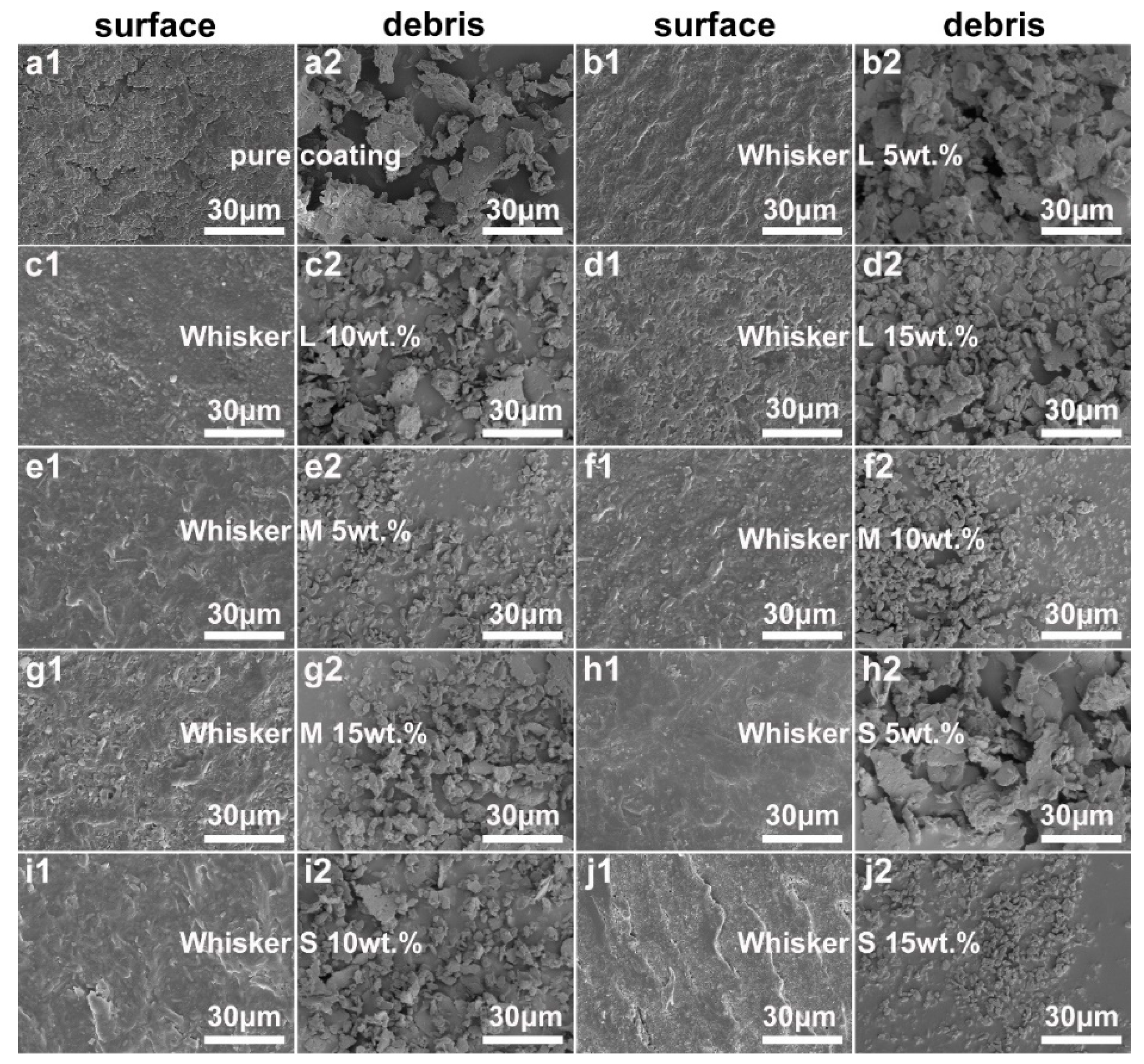
© 2019 by the authors. Licensee MDPI, Basel, Switzerland. This article is an open access article distributed under the terms and conditions of the Creative Commons Attribution (CC BY) license (http://creativecommons.org/licenses/by/4.0/).
Share and Cite
Zhang, J.; Li, C.; Yan, K.; Shen, L.; Bao, N. Influence of the Aspect Ratio of Sodium Iron Titanate Whiskers on the Mechanical and Tribological Performances of Fluorocarbon Composite Coatings. Coatings 2019, 9, 683. https://doi.org/10.3390/coatings9100683
Zhang J, Li C, Yan K, Shen L, Bao N. Influence of the Aspect Ratio of Sodium Iron Titanate Whiskers on the Mechanical and Tribological Performances of Fluorocarbon Composite Coatings. Coatings. 2019; 9(10):683. https://doi.org/10.3390/coatings9100683
Chicago/Turabian StyleZhang, Jiazhi, Chang Li, Kelan Yan, Liming Shen, and Ningzhong Bao. 2019. "Influence of the Aspect Ratio of Sodium Iron Titanate Whiskers on the Mechanical and Tribological Performances of Fluorocarbon Composite Coatings" Coatings 9, no. 10: 683. https://doi.org/10.3390/coatings9100683
APA StyleZhang, J., Li, C., Yan, K., Shen, L., & Bao, N. (2019). Influence of the Aspect Ratio of Sodium Iron Titanate Whiskers on the Mechanical and Tribological Performances of Fluorocarbon Composite Coatings. Coatings, 9(10), 683. https://doi.org/10.3390/coatings9100683




